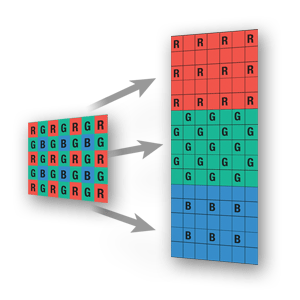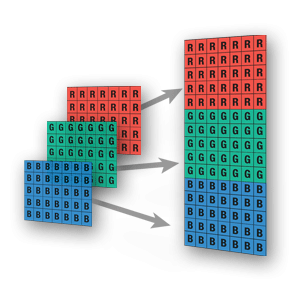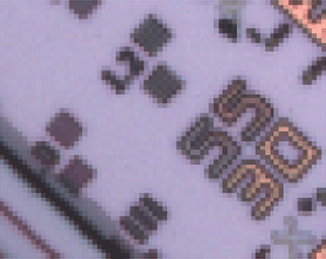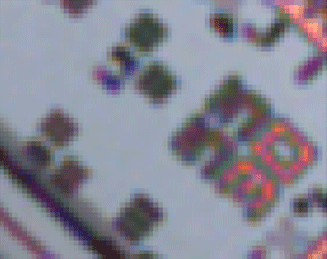Comparing Resolution Between Color Mosaic and 3-Shot Color Filter Cameras
The smallest imaging element on an imaging sensor is the pixel. It collects electrons that have been kicked into its potential well by incident photons during the exposure time. It then provides the digitizing component of the imaging system with a packet of charge. In a non-color imaging system, the resolving element of the system is equal to the pixel (not considering any optical system degradation).
Note that an electron kicked into the well by a 550 nm photon looks no different to the digitizer than an electron kicked into the well by a 450 nm photon. In digital RGB color camera systems, the color of the light is determined by sampling light intensity in three bands of the visible spectrum: Red (~530nm-700nm), Green( ~460nm-600nm) and Blue (~400nm- 500nm). The color RGB digital image then typically consists of an array of data with three values for each pixel location corresponding to the red, green and blue color intensities for that location. Color image sampling and creation can be achieved by different methods, each with it’s own advantages and disadvantages. Two popular methods in common use are Single Shot Color Mosaic Sampling and Three Shot Color Sampling.
Color Mosaic Cameras
One method of color sampling is to apply a red, green, or blue color filter directly onto each pixel. The filters are most commonly applied in a repeating, four pixel element called a Bayer Filter Pattern.

To create a color image, a single exposure is taken, resulting in a sampling of only one of the primary red, green or blue colors at each pixel location. The two un-sampled colors are then interpolated from adjacent pixels that have values for the color being calculated (Note that the other colors do not contribute anything to the color being calculated). To construct a color RGB image from this sampling method, 66% of the intensity values must be calculated. Also note that the resolving element is the 2×2 Bayer Filter Pattern that was used to sample the image with. This means that an image captured by a 2048 x 2048 sensor actually has resolution of only 1024 x1024. How does this happen? Envision that we create a perfectly small ray of red light that falls entirely onto one red pixel with no other light falling on the sensor. What will the image look like? First, the red pixel that the red ray fell onto, will very accurately record its intensity value, but now the eight adjacent pixels, that had no red light falling onto them will each have a value of red light calculated for them due to the interpolation. The resulting image will actually represent the one pixel ray as being a nine pixel ray. Now imagine if our red ray fell onto a blue or green pixel, the resulting image would show nothing!
Other artifacts also result from this sampling method. Thin white lines and extreme brightness transition edges in images can appear to have color stripes due to sampling and interpolation errors. Since each color is sampled at each pixel, the resolving element of the system is the pixel, making the stated resolution of the system equal to the resolution of the image sensor. This means that an image captured by a 2048 x 2048 sensor maintains its 2048 x 2048 resolution. Also note that the saved file size did not change, it just contained more measured data. One drawback to this method is that if the image is changing with time, the sequential image capture will produce an image with red, green and blue ghosts of your subject as it moves across the scene. Another possible concern is image exposure and capture time. This method triples the time, so if it is an issue with a single shot it will be more of an issue with the three-shot method.
Three Shot Color Filter Cameras
Another method of color sampling is to position a color changing filter element in front of the image sensor, then sequentially capture a red image, a green image and a blue image. The three sets of image data are then combined pixel by pixel to provide RGB sampled color at each pixel location.

Pick the Technology That Best Fits Your Application
As with any situation the appropriate solution depends on your needs. If you have moving samples or need highthroughput, then single shot color mosaic cameras would be most appropriate. If your sample is fixed and you have additional time, then you may benefit from the additional resolution available from three shot color cameras.



